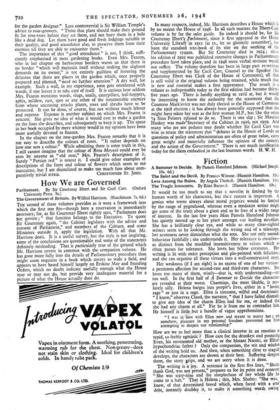Couple or Congeries? -
The Cowden Clarkes. By Richard Altick. - (Oxford University Press. 18s.) COWDEN CLARICE is known to lovers of Keats as the schoolmaster who initiated him into the mystery of verse-making and first led the youthful poet to Leigh Hunt's house in the Vale of Health. Mary Clarke is known as the compiler of a Shakespeare concordance which aimed at doing for the Shakespeare plays the work Cruden had done for the Bible in the eighteenth century. It •is difficult to regard Clarke as an arresting figure. He was less of a personality than Mary, who added to her bubbling Novello enthusiasm for music her own Shakespearian obsession. Between them they spanned an arc of 113 years ; that is to say Clarke was born four years before the French Revolution and Mary died the year after Queen Victoria's Diamond Jubilee. The fact that they belonged to different generations has inveigled the author of this book to set before us a crowded and rather confused scene in which principals, ancestors, collaterals and casual contacts jostle for place. The first chapter in Mr..Altick's book is roguishly entitled, "Come they of noble birth ? " to which the answer presumably is "No," as Mary's grandfather was a confectioner and Charles's father a school- teacher. Each succeeding chapter is headed with a quotation from Shakespeare supposedly appropriate to its contents, "All his golden words," "Her infinite variety," and so on. In the chapter "Yonder comes a poet" we hear of Keats as a boy at Enfield school, of his reading of the Faerie Queene, the poem that first released for him "the flood-gates of pbetry," of his apprenticeship to the apothecary- surgeon at Edmonton, incidents that took place while Mary was still
for the garden designer." Less controversial is Sir William Temple's advice to rose-growers. "Those that plant should make their ground fit for rose-trees before they set them, and not bury them in a hole like a dead dog. Let them have good and fresh lodgings suitable to their .quality, and good attendance also, to preserve them from their enemies till they are able to encounter them."
The importance of this "good attendance" is not, I think, suffi- ciently emphasised in most gardening books. Even Mrs. Fearon, who in her chapter on herbaceous borders warns us that there is no border "which will maintain itself without making the slightest demands on its owner," is not entirely guiltless of fostering the delusion that there are places in the garden which, once properly prepared and planted, "need no further attention." A dry wall, for example. Such a wall, in my experience, soon gets smothered with weeds, if one leaves it to take care of itself. It is curious how seldom Mrs. Fearon mentions weeds, slugs, snails, caterpillars, leaf-hoppers, aphis, mildew, rust, spot or any other of the innumerable enemies from whose unceasing attacks plants, trees and shrubs have to• be protected. It can be done, of course, but not without much labour and expense. Expense is another subject on which Mrs. Fearon is reticent. She gives no idea of what it would cost to make a garden on the lines she describes, and subsequently to keep it up. The space in her book occupied by mere whimsy would in my opinion have been more usefully devoted to finance.
In the chapter on the rose-garden Mrs. Fearon remarks that it is not easy to describe the colours of roses. "It rather depends on how one sees a colour." While admitting there is some truth in this, I still cannot imagine that the colour of Rosa Moyesii could ever be seen by anyone as "old rose," Mrs. Fearon's description of it. Surely "Persian red" is nearer it. I could give other examples of descriptions of the form and colour of flowers which seem to me inaccurate, but I am disinclined to make too much fuss about com-





































 Previous page
Previous page